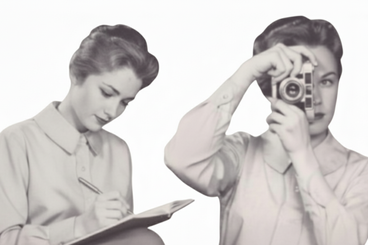
Women with a camera (and a notebook, a pen, a laptop...)
A series of seminars organized by Donata Meneghelli and Beatrice Seligardi
The seminars focus on books or projects that have some analogy with the book form, even to expand, subvert or enhance it, created by contemporary women artists. The underlying assumption is that there is a special relationship between women and photography, similar to that postulated by Virginia Woolf between women and writing.
In A Room of One's Own, Virginia Woolf argued that if there had been many more women writers than painters or sculptors throughout history, it was because a notebook, a ream of paper and a pen, as well as writing itself, were light, flexible, portable media, capable of blending in or mixing with everyday activities, inexpensive, somehow 'poor', or at least poorer than a studio, a box of colours, a set of brushes, a canvas or a slab of marble. Could the same be said of the camera between the late 19th and early 20th centuries, especially after the so-called 'Kodak revolution', which made the technology less cumbersome, more manageable and more accessible (and couldn’t it equally be said of another revolution, the advent of digital photography and the smartphone)?
Women have written, both in more marginal or private forms (diaries, letters) and in official and public ones, both in the more ephemeral, commercial press, considered devoid of any cultural capital, and in more noble and traditional media such as books, often treading the line between amateur and professional practices, exploring the interstitial spaces that divide them (just think of Jane Austen's juvenilia, composed for the family circle). And women have photographed, or manipulated photographic images, in different contexts, both within and outside the institutional perimeters of photography, although their presence has only been recognised and legitimised in relatively recent times.
What happens, then, when women intertwine writing, its supports and the photographic image?
The aim is to answer this question by intersecting different areas of reflection: the relationships between photography and writing, but also their coexistence within the same material space, the book and its many incarnations, and in the same expressive gesture; the relationships between gender and artistic practices; the photo-text as a form that, in women's production, relates to a typically female activity, that of the family album, a site of memorial and identity construction, a domestic - but also social and socialised - intermedial genre, in which women creatively composed and edited photography together with writing and sometimes drawing; the transition from a private, informal, vernacular dimension to a public dimension and other cultural domains; the photo-text, again, also considered in the broader context of collage techniques, far beyond art history.
The cycle will be mixed in nature. There will be artists invited to exhibit and discuss their work in person, as well as scholars who will take on the task of presenting and thus mediating the work of artists who are not physically present in front of the public, a solution that also allows us to explore the convergences or tensions between critical metadiscourse and thought in action, that produced by practitioners. The artists we have chosen or approached are very different from one another but have one thing in common: they have not yet been fully canonised, for a variety of reasons, ranging from unequal circulation in different linguistic and geographical areas, and therefore from translation and export policies, to the eccentric position that can make them difficult to classify and therefore assimilate, to the choice of a deliberately secluded stance. These meetings therefore also reflect a desire to break away from the beaten track in order to reconstruct a more eclectic and multifaceted panorama (corpus), one that challenges our interpretative categories.
The seminars will take place monthly from November 2025 to June 2026 at the Department of Classical Philology and Italian Studies, Via Zamboni 32.